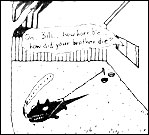|
Up to the present there has been two contrasting
features aired on the website : Dumbland and Rabbits.
Dumbland is a crude flash animated venture with voices
created by Lynch himself (2),
whilst Rabbits is a project which will no doubt appeal
to the hardcore set of Lynch’s fan base as it is as far removed
from Dumbland as it is possible to get in terms of
theme, quality, ambience and execution. There is also a third
series penned in the mysterious Axxon N. (little of
which is known about, although a poster on
www.davidlynch.com does stress that it is “Rated for
mature viewers” (3))
that at the moment requires further funding to bring it to
fruition. But it is Rabbits which is what I want to
discuss here, although trying to forecast any form of denouement
in terms of closure would be futile at this stage in the proceedings,
primarily because Lynch favours open rather than closed systems
of narrative.
Rabbits features the talents of
Mulholland Drive’s two leading ladies Naomi
Watts (Suzi), Laura Elena Harring (Jane), and Scott Coffey
(Jack), a David Lynch regular who has appeared in minor roles
(4) in Lost Highway (as Teddie), Wild
at Heart (his character Billie was edited from the final
cut of the movie) and Mulholland Drive (as Wilkins
- a character who had a larger part when the series was a
pilot, but is reduced to nothing more than a cameo appearance
in the Adam and Camilla engagement scene). It is ironic then
that Scott’s appearance in Rabbits protracts his anonymity
in Lynch’s œuvre by requiring him and his co-stars to remain
hidden behind Bunny costumes. This may seem cruel on the surface,
but it infact plays into the hands of Lynch’s obsession with
the hidden and identity. It also comes in useful for continuing
the series of Rabbits with stand in actors should the
regulars have prior commitments. A substitution of an actress
does actually occur in episode 3 when Mulholland Drive’s
Chanteuse Rebekah Del Rio stands in for Laura Elena Harring’s
character Jane, although this could be because Lynch wanted
to resurrect her vocal abilities for this portion of the series.
The irony of the situation (which is perhaps Lynch’s humorous
intention) is that the viewing public would be none the wiser
whoever was underneath the costumes, all that would be required
would be a voice over to cement the illusion of unity for
future episodes. This cynical ploy could indeed be the raison
d’être for the using the form of the Rabbit in an otherwise
all to human affair. But are there other reasons for using
non human creatures to portray events which could otherwise
have been enacted by beings of a non animal variety ?
| |
 |
|
|
David Lynch has of course
used animals within his back catalogue of work before. Dogs
for instance feature in nearly every one of his movies usually
as a visual prop : who could forget the scene in Wild
At Heart in which our canine friend scampers
away with the Bank teller’s severed hand ? Or the mewling
pups in Mary X’s living room in Eraserhead ? Indeed
a dog, albeit in cartoon form, took centre stage in Lynch’s
cartoon series for the L.A Reader The Angriest
Dog In The World. But it is here
on his website that Lynch seems to be opening up more to the
wonders of nature : Bees, Coyotes, and
Dead Mice all have a part to play in various
guises and manifestations within www.davidlynch.com
(5), and as part of the pay per view series the
Rabbit has been given the starring role.
There could be and probably
are several reasons why Lynch has chosen this particular animal :
they are universally known for their prodigious sexual activity,
they have an aesthetic physicality, which has been appropriated
throughout culture for their anthropomorphic qualities. They
are frequently used in dream symbolism and it could be argued
that they are also nervous creatures, emblematic of fear.
All these reasons seem feasible motivations to entice Lynch’s
interest but it is highly unlikely that he should have elected
them as candidates for any great metaphysical intrigue this
late on in his career, especially since there is no indication
that he has shown any type of fetish for them in his previous
work. No, the choice of Rabbits was probably taken for artistic
and practical reasons : Rabbits are a creature that have
the correct morphology of representation : their physicality
looks correct when matched to Lynch’s “Eye Of
The Duck“ principle (the duck being a perfectly
symmetrical creature in Lynch’s perception, and therefore
used as a criteria for esthetical composition) (6).
They are also one of the most popular creatures when displaying
“Wall Shadows” as their outlines project well onto a room’s
backdrop, which is an artistic feature of this series that
serves the lighting arrangements very favourably : indeed
the silhouette of a rabbit can be seen on the website’s design
poster which conjures up images of film noir, intrigue and
mystery.
|